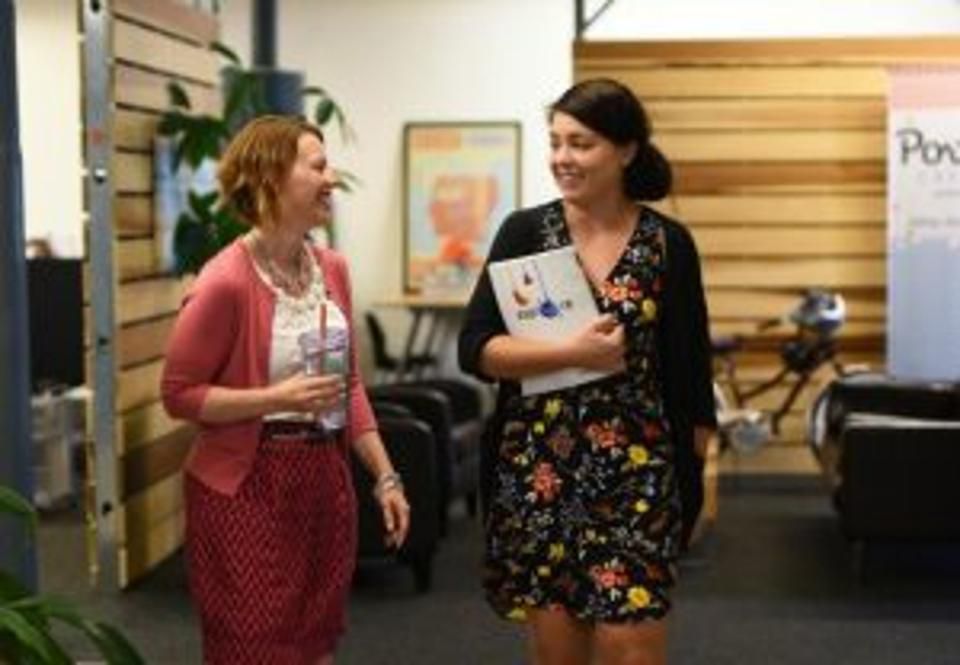
by Aileron
Republished from Forbes, January 8, 2018
“People picked on my generation. People picked on my fathers’ generation. People are picking on this generation, and I think it’s wrong,” says Scott McGohan, CEO at McGohan Brabender, a company that provides employee benefit consulting, compliance, and health risk management.
“We have to understand technology and communication paths that are going to be attractive [across generations], but to pretend that they’re going to think differently than a lot of us—I think it’s immature,” says Scott.
“ Stop trying to figure out generations. If you just care about people, you’ll be fine ,” he says. “When we just lead with our heart, in my opinion, we win every time.”
Kristen Harris, COO and Co-Founder of Portfolio Creative, a fast-growing, nationwide creative recruiting and staffing agency, agrees. While statements about generations may sometimes be constructive, building relationships with team members is all about caring enough to get to know them as individuals. “Our approach is to understand each of them individually, which is much more valuable for us,” says Kristen.
“For example, I would prefer an email, in many cases, since it’s more visual, but my partner actually would prefer you call her. We’re the same age, and we’re in the same generation, but we’re different individual people and we each have our preferences,” says Kristen.
“I’ve just always found it’s more helpful to know that each person has individual preferences and differences, especially when you get into leading people. You’re working one-on-one with them—regardless of their age.”
Although not a comprehensive list, here are two key ways Portfolio Creative puts people first in their quest to foster a culture where individuals, and the team, can thrive:
1. Shift into the mindset that you’re always relationship-building
Observation can go a long way in getting to know others, and how they do their best work. “It’s really important for a leader to just observe the people that are on their team—and to talk to them.”
Don’t hold back from asking someone how they do their best work. “We’ll have one-on-one conversations asking team members questions about their preferences and their energy levels and that kind of thing,” says Kristen. “That may sound like, ‘What do you like? What’s important to you? What motivates you? How do you like to be communicated with?’” says Kristen.
“Last week, I found out someone on my team is really much more of a morning person. That is so helpful for me to know because I always schedule our meetings in the afternoon. Now I know we can do that in the morning when that person is feeling much more sharp and more lively,” says Kristen. “Little things such as that can be so helpful in your working relationship. It has nothing to do with generation or age.”
2. Build on individuals’ strengths
Once a team member has joined the company, they take the StrengthsFinder assessment so that they can become more self-aware and so that team members can also help them focus on their strengths.
“It’s a very positive perspective that you can take advantage of,” explains Kristen. “We know what we can tap into and what we can help them leverage. A lot of times people have never heard of or thought about that. It’s really enlightening for them to think about what they are really good at and how they can best utilize those strengths.”
They also use the Color Code Personality Assessment which helps the team to know more about one another’s personalities. “We tend to be very visual people here and so this has really stuck and worked well for us.”
Once a team member has taken the assessment, they are given tools to help them improve their communication with others.
“My partner, Catherine Lang-Cline, is what they call a ‘Red,’ meaning she’s very direct. She walks up to you and says, “Hey, here’s what I need. Thanks. Great,’ and goes back to her desk.” Then there’s a color ‘Blue,’ which captures detail-oriented personalities that are in-tune with other people and often strive to satisfy people. For this personality, the “Red” style of communication can feel harsh, abrupt, or it can even be interpreted as cold.
But once team members learn about each other, they can adjust their communication style so that others can be more perceptive to them. In this example, Catherine has learned to shift the way she approaches others. “She’s still saying exactly what she needed to, but she realized she has to ease in with a little bit of a chit chat. And when she does, she sees the response is so much more positive.”
“It’s about understanding your personality and what’s going on in someone’s mind when they hear you and communicate with you. We all interpret through a filter so this is helpful to understand and improve communication. It allows us to check ourselves every once in a while,” adds Kristen.
“It’s all about genuinely understanding the other person,” says Kristen.
“A lot of times we want to do what is comfortable for us. Being able to understand the other person and to make yourself uncomfortable to make them more comfortable is tough but, again, as a leader it’s part of how you get the best out of your people. You put yourself in the awkward position to make them shine.”
This capacity can be embedded in the DNA across the organization. “It’s a two way street, no matter someone’s position in the company,” says Kristen.
